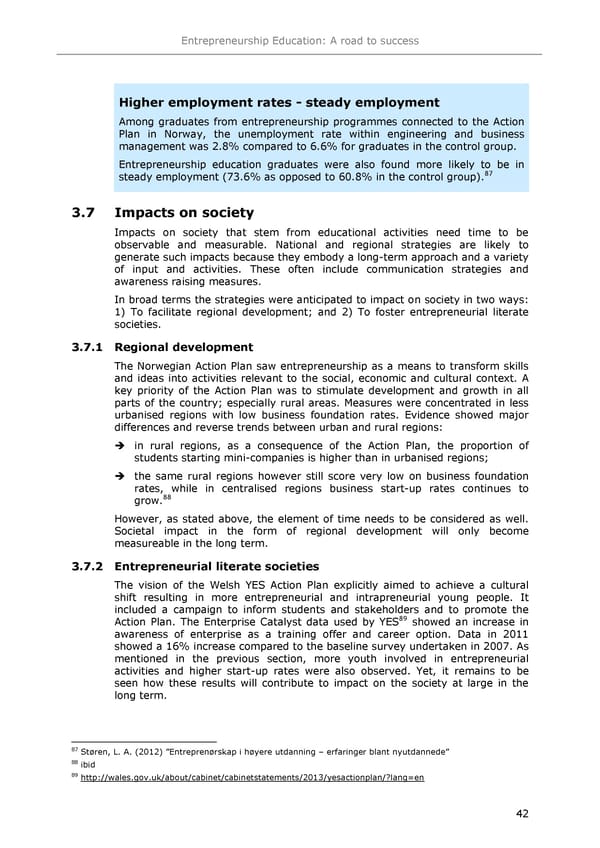Entrepreneurship Education: A road to success Higher employment rates - steady employment Among graduates from entrepreneurship programmes connected to the Action Plan in Norway, the unemployment rate within engineering and business management was 2.8% compared to 6.6% for graduates in the control group. Entrepreneurship education graduates were also found more likely to be in steady employment (73.6% as opposed to 60.8% in the control group).87 3.7 Impacts on society Impacts on society that stem from educational activities need time to be observable and measurable. National and regional strategies are likely to generate such impacts because they embody a long-term approach and a variety of input and activities. These often include communication strategies and awareness raising measures. In broad terms the strategies were anticipated to impact on society in two ways: 1) To facilitate regional development; and 2) To foster entrepreneurial literate societies. 3.7.1 Regional development The Norwegian Action Plan saw entrepreneurship as a means to transform skills and ideas into activities relevant to the social, economic and cultural context. A key priority of the Action Plan was to stimulate development and growth in all parts of the country; especially rural areas. Measures were concentrated in less urbanised regions with low business foundation rates. Evidence showed major differences and reverse trends between urban and rural regions: in rural regions, as a consequence of the Action Plan, the proportion of students starting mini-companies is higher than in urbanised regions; the same rural regions however still score very low on business foundation rates, while in centralised regions business start-up rates continues to 88 grow. However, as stated above, the element of time needs to be considered as well. Societal impact in the form of regional development will only become measureable in the long term. 3.7.2 Entrepreneurial literate societies The vision of the Welsh YES Action Plan explicitly aimed to achieve a cultural shift resulting in more entrepreneurial and intrapreneurial young people. It included a campaign to inform students and stakeholders and to promote the 89 Action Plan. The Enterprise Catalyst data used by YES showed an increase in awareness of enterprise as a training offer and career option. Data in 2011 showed a 16% increase compared to the baseline survey undertaken in 2007. As mentioned in the previous section, more youth involved in entrepreneurial activities and higher start-up rates were also observed. Yet, it remains to be seen how these results will contribute to impact on the society at large in the long term. 87 Støren, L. A. (2012) =Entreprenørskap i høyere utdanning 3 erfaringer blant nyutdannede= 88 ibid 89 http://wales.gov.uk/about/cabinet/cabinetstatements/2013/yesactionplan/?lang=en 42
 Entrepreneurship Education Page 45 Page 47
Entrepreneurship Education Page 45 Page 47